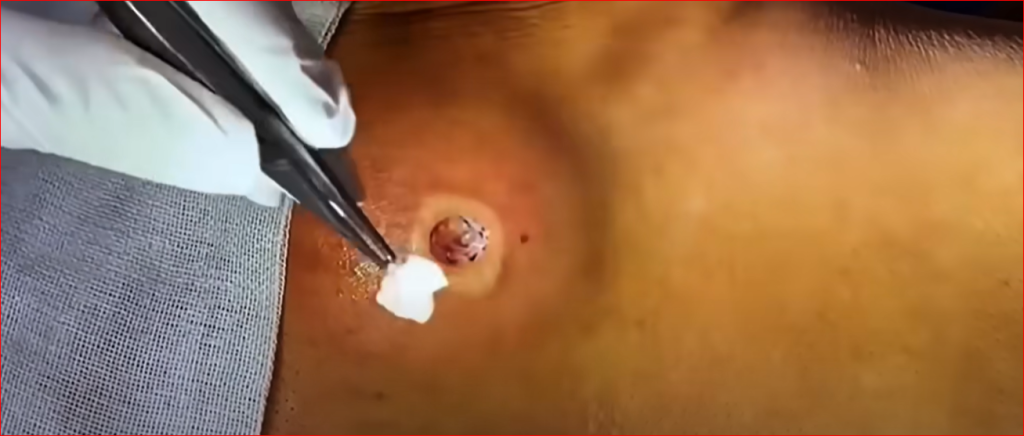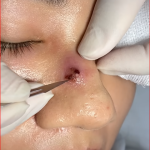Removing a sebaceous cyst—especially if it’s not infected—can often be a quick, minor procedure. Here’s a detailed step-by-step breakdown of how sebaceous cyst removal is typically done:
🔬 Step-by-Step: Sebaceous Cyst Removal Procedure
✅ 1. Medical Evaluation
-
A healthcare provider examines the cyst to confirm it’s a sebaceous (epidermoid) cyst.
-
If it’s not infected, it can often be removed on the same day.
-
If it is infected, they’ll usually treat the infection first, then remove the cyst later.
💉 2. Local Anesthesia
-
A local anesthetic (like lidocaine) is injected to numb the area.
-
This ensures you feel pressure but no pain during the procedure.
✂️ 3. Incision
-
A small cut is made directly over the cyst.
-
The size depends on the cyst’s size and location.
🫳 4. Cyst Removal
-
The goal is to remove the cyst sac (wall) intact to prevent recurrence.
-
The doctor gently squeezes or dissects around the sac to remove it fully.
🧠 Fun fact: If the sac breaks during removal, it’s not a big deal—it just takes more care to remove all parts to prevent the cyst from coming back.
🧵 5. Stitches (Sutures)
-
The incision is usually closed with a few stitches.
-
For small cysts, sometimes no stitches are needed—they heal with a bandage.
🧼 6. Aftercare
-
Keep the area clean and dry.
-
You may be prescribed antibiotic ointment or pills (if infection risk exists).
-
Stitches are typically removed in 7–10 days.
⏱️ Recovery Time
-
Most people return to normal activities the same or next day.
-
Minor soreness, swelling, or bruising is normal for a few days.
⚠️ Don’t Try This at Home
Trying to remove a sebaceous cyst yourself can lead to:
-
Infection
-
Scarring
-
Cyst recurrence
Removing a sebaceous cyst is a common minor surgical procedure performed by dermatologists and general surgeons. The approach varies based on factors like cyst size, location, and whether it’s infected. Below is a detailed overview of the standard techniques for sebaceous cyst removal, supported by medical references.
🩺 Standard Techniques for Sebaceous Cyst Removal
1. Minimal Excision Technique
This method involves a small incision to remove the cyst sac intact, minimizing scarring and reducing the risk of recurrence.
Procedure Steps:
-
Preparation: The skin over the cyst is cleansed with an antiseptic solution, and local anesthesia (typically 2% lidocaine with epinephrine) is administered to numb the area.
-
Incision: A small incision (approximately 2–3 mm) is made directly over the cyst.
-
Cyst Removal: The cyst is carefully expressed or dissected from the surrounding tissue. If the cyst wall is intact, it is removed entirely.
-
Closure: The incision may be closed with a single suture or left open, depending on the case.
-
Aftercare: A sterile dressing is applied, and the patient is advised on wound care and signs of infection.AAFP+1PMC+1PMC
This technique is particularly effective for cysts that are not inflamed and are located in areas where cosmetic outcomes are important.
2. Laser-Assisted Excision
A newer approach involves using a carbon dioxide laser to create a small hole in the cyst, allowing for the removal of its contents. After a healing period, the cyst wall is excised through a minimal incision.AAFP+3PMC+3NCBI+3
Procedure Steps:
-
Initial Treatment: A laser is used to make a small hole in the cyst, and the contents are expressed or drained.
-
Healing Period: The patient is monitored for about a month to ensure proper healing.
-
Cyst Wall Removal: A small incision is made over the cyst wall, which is then removed entirely.
-
Closure: The incision is closed, and the area is dressed appropriately.Pristyn Care+2PMC+2NCBI+2Pristyn Care+1PMC+1
This method is beneficial for large cysts or those located in areas where traditional excision might result in noticeable scarring. PMC+1NCBI+1
3. Conventional Wide Excision
This traditional method involves making a larger incision to remove the cyst and surrounding tissue. While effective, it may result in a more noticeable scar.
Procedure Steps:
-
Preparation: The area is cleansed, and local anesthesia is administered.
-
Incision: A larger incision is made to access the cyst and surrounding tissue.
-
Cyst Removal: The cyst and a margin of surrounding tissue are excised.
-
Closure: The incision is closed with sutures.
-
Aftercare: Post-operative care instructions are provided to promote healing.
This approach is often used when the cyst is infected or when a more thorough removal is necessary. Pristyn Care
🧠 Additional Considerations
-
Infected Cysts: If a cyst is infected, it may need to be drained and treated with antibiotics before surgical removal.
-
Post-Operative Care: Patients are typically advised to keep the area clean and dry, avoid squeezing the site, and monitor for signs of infection.
-
Recurrence Prevention: Ensuring the entire cyst wall is removed is crucial to prevent recurrence.
📚 References
-
Verywell Health. (2003). What Are Sebaceous Cysts? Retrieved from Verywell Health
-
Wu, H., Wang, S., Wu, L., & Zheng, S. (2009). A New Procedure for Treating a Sebaceous Cyst: Removal of the Cyst Content with a Laser Punch and the Cyst Wall with a Minimal Postponed Excision. Aesthetic Plastic Surgery, 33(4), 597–599. https://doi.org/10.1007/s00266-009-9331-2
-
American Academy of Family Physicians. (2002). Minimal Excision Technique for Epidermoid (Sebaceous) Cysts. American Family Physician, 65(7), 1409–1411. https://www.aafp.org/pubs/afp/issues/2002/0401/p1409.html


